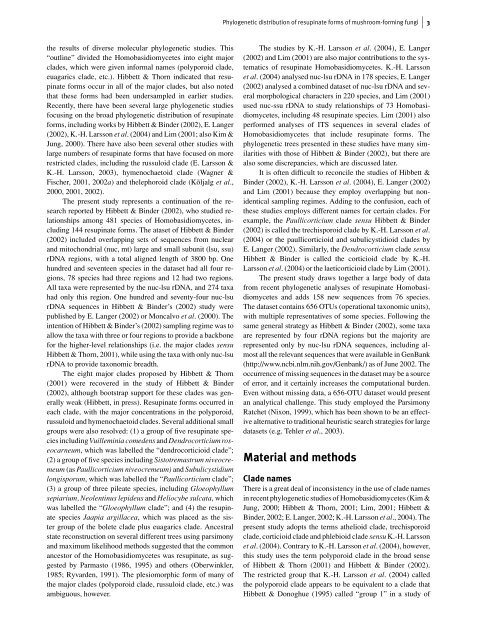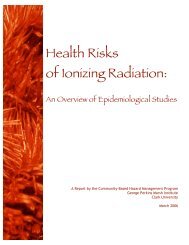The phylogenetic distribution of resupinate forms ... - Clark University
The phylogenetic distribution of resupinate forms ... - Clark University
The phylogenetic distribution of resupinate forms ... - Clark University
Create successful ePaper yourself
Turn your PDF publications into a flip-book with our unique Google optimized e-Paper software.
the results <strong>of</strong> diverse molecular <strong>phylogenetic</strong> studies. This<br />
“outline” divided the Homobasidiomycetes into eight major<br />
clades, which were given informal names (polyporoid clade,<br />
euagarics clade, etc.). Hibbett & Thorn indicated that <strong>resupinate</strong><br />
<strong>forms</strong> occur in all <strong>of</strong> the major clades, but also noted<br />
that these <strong>forms</strong> had been undersampled in earlier studies.<br />
Recently, there have been several large <strong>phylogenetic</strong> studies<br />
focusing on the broad <strong>phylogenetic</strong> <strong>distribution</strong> <strong>of</strong> <strong>resupinate</strong><br />
<strong>forms</strong>, including works by Hibbett & Binder (2002), E. Langer<br />
(2002), K.-H. Larsson et al. (2004) and Lim (2001; also Kim &<br />
Jung, 2000). <strong>The</strong>re have also been several other studies with<br />
large numbers <strong>of</strong> <strong>resupinate</strong> <strong>forms</strong> that have focused on more<br />
restricted clades, including the russuloid clade (E. Larsson &<br />
K.-H. Larsson, 2003), hymenochaetoid clade (Wagner &<br />
Fischer, 2001, 2002a) and thelephoroid clade (Kõljalg et al.,<br />
2000, 2001, 2002).<br />
<strong>The</strong> present study represents a continuation <strong>of</strong> the research<br />
reported by Hibbett & Binder (2002), who studied relationships<br />
among 481 species <strong>of</strong> Homobasidiomycetes, including<br />
144 <strong>resupinate</strong> <strong>forms</strong>. <strong>The</strong> ataset <strong>of</strong> Hibbett & Binder<br />
(2002) included overlapping sets <strong>of</strong> sequences from nuclear<br />
and mitochondrial (nuc, mt) large and small subunit (lsu, ssu)<br />
rDNA regions, with a total aligned length <strong>of</strong> 3800 bp. One<br />
hundred and seventeen species in the dataset had all four regions,<br />
78 species had three regions and 12 had two regions.<br />
All taxa were represented by the nuc-lsu rDNA, and 274 taxa<br />
had only this region. One hundred and seventy-four nuc-lsu<br />
rDNA sequences in Hibbett & Binder’s (2002) study were<br />
published by E. Langer (2002) or Moncalvo et al. (2000). <strong>The</strong><br />
intention <strong>of</strong> Hibbett & Binder’s (2002) sampling regime was to<br />
allow the taxa with three or four regions to provide a backbone<br />
for the higher-level relationships (i.e. the major clades sensu<br />
Hibbett & Thorn, 2001), while using the taxa with only nuc-lsu<br />
rDNA to provide taxonomic breadth.<br />
<strong>The</strong> eight major clades proposed by Hibbett & Thorn<br />
(2001) were recovered in the study <strong>of</strong> Hibbett & Binder<br />
(2002), although bootstrap support for these clades was generally<br />
weak (Hibbett, in press). Resupinate <strong>forms</strong> occurred in<br />
each clade, with the major concentrations in the polyporoid,<br />
russuloid and hymenochaetoid clades. Several additional small<br />
groups were also resolved: (1) a group <strong>of</strong> five <strong>resupinate</strong> species<br />
including Vuilleminia comedens and Dendrocorticium roseocarneum,<br />
which was labelled the “dendrocorticioid clade”;<br />
(2) a group <strong>of</strong> five species including Sistotremastrum niveocremeum<br />
(as Paullicorticium niveocremeum) and Subulicystidium<br />
longisporum, which was labelled the “Paullicorticium clade”;<br />
(3) a group <strong>of</strong> three pileate species, including Gloeophyllum<br />
sepiarium, Neolentinus lepideus and Heliocybe sulcata,which<br />
was labelled the “Gloeophyllum clade”; and (4) the <strong>resupinate</strong><br />
species Jaapia argillacea, which was placed as the sister<br />
group <strong>of</strong> the bolete clade plus euagarics clade. Ancestral<br />
state reconstruction on several different trees using parsimony<br />
and maximum likelihood methods suggested that the common<br />
ancestor <strong>of</strong> the Homobasidiomycetes was <strong>resupinate</strong>, as suggested<br />
by Parmasto (1986, 1995) and others (Oberwinkler,<br />
1985; Ryvarden, 1991). <strong>The</strong> plesiomorphic form <strong>of</strong> many <strong>of</strong><br />
the major clades (polyporoid clade, russuloid clade, etc.) was<br />
ambiguous, however.<br />
Phylogenetic <strong>distribution</strong> <strong>of</strong> <strong>resupinate</strong> <strong>forms</strong> <strong>of</strong> mushroom-forming fungi 3<br />
<strong>The</strong> studies by K.-H. Larsson et al. (2004), E. Langer<br />
(2002) and Lim (2001) are also major contributions to the systematics<br />
<strong>of</strong> <strong>resupinate</strong> Homobasidiomycetes. K.-H. Larsson<br />
et al. (2004) analysed nuc-lsu rDNA in 178 species, E. Langer<br />
(2002) analysed a combined dataset <strong>of</strong> nuc-lsu rDNA and several<br />
morphological characters in 220 species, and Lim (2001)<br />
used nuc-ssu rDNA to study relationships <strong>of</strong> 73 Homobasidiomycetes,<br />
including 48 <strong>resupinate</strong> species. Lim (2001) also<br />
performed analyses <strong>of</strong> ITS sequences in several clades <strong>of</strong><br />
Homobasidiomycetes that include <strong>resupinate</strong> <strong>forms</strong>. <strong>The</strong><br />
<strong>phylogenetic</strong> trees presented in these studies have many similarities<br />
with those <strong>of</strong> Hibbett & Binder (2002), but there are<br />
also some discrepancies, which are discussed later.<br />
It is <strong>of</strong>ten difficult to reconcile the studies <strong>of</strong> Hibbett &<br />
Binder (2002), K.-H. Larsson et al. (2004), E. Langer (2002)<br />
and Lim (2001) because they employ overlapping but nonidentical<br />
sampling regimes. Adding to the confusion, each <strong>of</strong><br />
these studies employs different names for certain clades. For<br />
example, the Paullicorticium clade sensu Hibbett & Binder<br />
(2002) is called the trechisporoid clade by K.-H. Larsson et al.<br />
(2004) or the paullicorticioid and subulicystidioid clades by<br />
E. Langer (2002). Similarly, the Dendrocorticium clade sensu<br />
Hibbett & Binder is called the corticioid clade by K.-H.<br />
Larsson et al. (2004) or the laeticorticioid clade by Lim (2001).<br />
<strong>The</strong> present study draws together a large body <strong>of</strong> data<br />
from recent <strong>phylogenetic</strong> analyses <strong>of</strong> <strong>resupinate</strong> Homobasidiomycetes<br />
and adds 158 new sequences from 76 species.<br />
<strong>The</strong> dataset contains 656 OTUs (operational taxonomic units),<br />
with multiple representatives <strong>of</strong> some species. Following the<br />
same general strategy as Hibbett & Binder (2002), some taxa<br />
are represented by four rDNA regions but the majority are<br />
represented only by nuc-lsu rDNA sequences, including almost<br />
all the relevant sequences that were available in GenBank<br />
(http://www.ncbi.nlm.nih.gov/Genbank/) as <strong>of</strong> June 2002. <strong>The</strong><br />
occurrence <strong>of</strong> missing sequences in the dataset may be a source<br />
<strong>of</strong> error, and it certainly increases the computational burden.<br />
Even without missing data, a 656-OTU dataset would present<br />
an analytical challenge. This study employed the Parsimony<br />
Ratchet (Nixon, 1999), which has been shown to be an effective<br />
alternative to traditional heuristic search strategies for large<br />
datasets (e.g. Tehler et al., 2003).<br />
Material and methods<br />
Clade names<br />
<strong>The</strong>re is a great deal <strong>of</strong> inconsistency in the use <strong>of</strong> clade names<br />
in recent <strong>phylogenetic</strong> studies <strong>of</strong> Homobasidiomycetes (Kim &<br />
Jung, 2000; Hibbett & Thorn, 2001; Lim, 2001; Hibbett &<br />
Binder, 2002; E. Langer, 2002; K.-H. Larsson et al., 2004). <strong>The</strong><br />
present study adopts the terms athelioid clade, trechisporoid<br />
clade, corticioid clade and phlebioid clade sensu K.-H. Larsson<br />
et al. (2004). Contrary to K.-H. Larsson et al. (2004), however,<br />
this study uses the term polyporoid clade in the broad sense<br />
<strong>of</strong> Hibbett & Thorn (2001) and Hibbett & Binder (2002).<br />
<strong>The</strong> restricted group that K.-H. Larsson et al. (2004) called<br />
the polyporoid clade appears to be equivalent to a clade that<br />
Hibbett & Donoghue (1995) called “group 1” in a study <strong>of</strong>
















